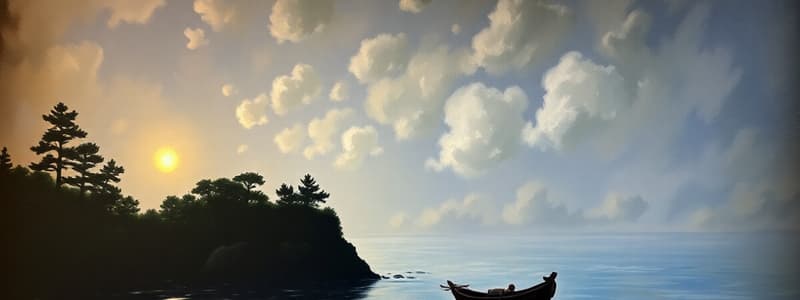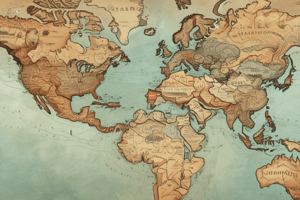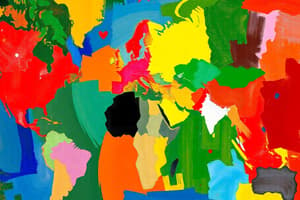Podcast
Questions and Answers
What is defined as countries with defined borders where the people share a common government and often a common culture or language?
What is defined as countries with defined borders where the people share a common government and often a common culture or language?
- Global System
- Anarchy
- Nation-state (correct)
- International security
What term describes a situation where there is no central authority or government, leading to a lack of order?
What term describes a situation where there is no central authority or government, leading to a lack of order?
- Nation-state
- Global System
- Balance of power
- Anarchy (correct)
Which of the following best describes the concept of 'balance of power'?
Which of the following best describes the concept of 'balance of power'?
- Participating in international organizations
- Matching power against another nation for self-protection (correct)
- Establishing cultural exchange programs
- A country's strategy to increase trade relations
How do nation-states typically address global issues while maintaining peaceful relations?
How do nation-states typically address global issues while maintaining peaceful relations?
Which of the following is NOT a sphere of international relations?
Which of the following is NOT a sphere of international relations?
What encompasses the safety and stability measures taken by countries and international organizations globally?
What encompasses the safety and stability measures taken by countries and international organizations globally?
Which example illustrates relations between societies in international relations?
Which example illustrates relations between societies in international relations?
What aspect of international relations does the Syrian refugee crisis exemplify?
What aspect of international relations does the Syrian refugee crisis exemplify?
What is the primary purpose of sanctions imposed by one country on another?
What is the primary purpose of sanctions imposed by one country on another?
Which of the following best describes the concept of sovereignty?
Which of the following best describes the concept of sovereignty?
What does the term 'balance of power' refer to in international relations?
What does the term 'balance of power' refer to in international relations?
What role do non-governmental organizations (NGOs) primarily play in international relations?
What role do non-governmental organizations (NGOs) primarily play in international relations?
What is one major consequence of sanctions on a country’s economy?
What is one major consequence of sanctions on a country’s economy?
In the context of international relations, what does globalization refer to?
In the context of international relations, what does globalization refer to?
Which of the following is NOT a key player in international relations?
Which of the following is NOT a key player in international relations?
How many countries are members of the United Nations?
How many countries are members of the United Nations?
What was the primary objective of the Containment policy during the Cold War?
What was the primary objective of the Containment policy during the Cold War?
Which of the following events marked the beginning of the Space Race?
Which of the following events marked the beginning of the Space Race?
What was a significant consequence of the Arms Race during the Cold War?
What was a significant consequence of the Arms Race during the Cold War?
Which symbol is associated with the communist state of the USSR?
Which symbol is associated with the communist state of the USSR?
What event in 1961 further highlighted the division of Germany?
What event in 1961 further highlighted the division of Germany?
What ideological difference contributed to the tension between the U.S. and the Soviet Union during the Cold War?
What ideological difference contributed to the tension between the U.S. and the Soviet Union during the Cold War?
Which event demonstrated the peak of tensions during the Cold War in 1962?
Which event demonstrated the peak of tensions during the Cold War in 1962?
What was a significant result of the weak European nations after World War II?
What was a significant result of the weak European nations after World War II?
What was a primary reason for the construction of the Berlin Wall in 1961?
What was a primary reason for the construction of the Berlin Wall in 1961?
Which event nearly led to nuclear war in 1962?
Which event nearly led to nuclear war in 1962?
What was the aim of the U.S. containment policy?
What was the aim of the U.S. containment policy?
What was a significant outcome of the Cuban Missile Crisis?
What was a significant outcome of the Cuban Missile Crisis?
What was the purpose of the Marshall Plan?
What was the purpose of the Marshall Plan?
Which of the following nations fell under communist influence despite U.S. efforts?
Which of the following nations fell under communist influence despite U.S. efforts?
What event marked the beginning of the easing of tensions between East and West Germany?
What event marked the beginning of the easing of tensions between East and West Germany?
Which U.S. President introduced the Truman Doctrine?
Which U.S. President introduced the Truman Doctrine?
What was one of the key economic policies that Reagan implemented to pressure the Soviet Union?
What was one of the key economic policies that Reagan implemented to pressure the Soviet Union?
Which reform introduced by Gorbachev aimed to promote freedom of speech among Soviet citizens?
Which reform introduced by Gorbachev aimed to promote freedom of speech among Soviet citizens?
What was a direct consequence of the increased military spending by the United States during Reagan's presidency?
What was a direct consequence of the increased military spending by the United States during Reagan's presidency?
Which of the following was NOT a factor contributing to the economic decline of the Soviet Union?
Which of the following was NOT a factor contributing to the economic decline of the Soviet Union?
What did Gorbachev's policy of perestroika primarily aim to achieve?
What did Gorbachev's policy of perestroika primarily aim to achieve?
How did glasnost affect nationalist movements within the Soviet Union?
How did glasnost affect nationalist movements within the Soviet Union?
What did citizens of the Soviet Union demand that aligned with Gorbachev’s reforms?
What did citizens of the Soviet Union demand that aligned with Gorbachev’s reforms?
Which outcome is a result of Gorbachev's policies according to the significant changes in the Soviet Union?
Which outcome is a result of Gorbachev's policies according to the significant changes in the Soviet Union?
Flashcards are hidden until you start studying
Study Notes
International Relations
- The study of international relations seeks to understand how countries and other global actors interact and influence each other.
- Key actors in international relations include states, international organizations, non-governmental organizations, multinational corporations, and individuals.
- Sovereignty is a core concept in international relations, referring to a state's right to govern itself without interference from other states.
- The balance of power is a strategy used by states to maintain security, ensuring that no one nation has an overwhelming amount of power.
Major Oceans and Continents
- The study of international relations often considers geographic influences, including major oceans like the Atlantic, Pacific, Indian, Arctic, and Southern Oceans.
- Continents such as North America, South America, Europe, Asia, Africa, and Australia are significant units of study, each with distinct geopolitical characteristics.
International Relations: Key Concepts
- Diplomacy is the art and practice of conducting negotiations between states, aiming to resolve conflicts, build alliances, and protect national interests.
- International Security deals with measures taken to protect the safety and stability of the global community, including responding to threats like terrorism, conflict, and nuclear proliferation.
- Global Governance addresses the need for cooperation between states to tackle global issues like climate change, poverty, and pandemics.
- Globalization is the growing interconnectedness of countries through trade, technology, travel, and cultural exchange.
- Foreign Policy is the set of goals, strategies, and actions a state takes in its interactions with the rest of the world.
- International Law comprises treaties, conventions, and customary practices that regulate interactions between states and govern global issues.
Key Players in International Relations
- States: Nation-states are the primary actors, each with its own government, territory, population, and international interests.
- International Organizations (IOs): Groups like the United Nations, World Trade Organization, and International Monetary Fund aim to address global issues and provide platforms for international cooperation.
- Non-Governmental Organizations (NGOs): Independent groups like the Red Cross, Amnesty International, and Greenpeace work on humanitarian, environmental, and other issues, often operating across borders.
- Multinational Corporations (MNCs): Businesses with operations in multiple countries, often with significant economic and political influence.
- Individuals: People who can shape international relations, including activists, diplomats, scholars, and leaders.
Foundations of International Relations:
- International relations as a discipline emerged in the early 20th century, aiming to understand and potentially resolve conflict, particularly after World War I.
Communism & the Cold War
- Communism: A political and economic ideology that promotes a classless society where the state controls the means of production.
- Cold War: A period of geopolitical tension and rivalry between the United States and the Soviet Union from the end of World War II until the early 1990s.
- Containment: A US foreign policy strategy during the Cold War aimed at preventing the spread of communism.
- Arms Race: A competition between the US and USSR to develop the most powerful nuclear weapons and military capabilities.
- Space Race: A competition between the US and USSR to achieve dominance in space exploration.
- Berlin Wall: Built in 1961 to divide East and West Berlin, symbolizing the division of a communist East and a capitalist West.
Key Events & Players in the Cold War
- The Soviet Union (USSR): Founded in 1917, the USSR was a communist state that grew to encompass many Eastern European nations.
- NATO (North Atlantic Treaty Organization): A military alliance formed to contain communist expansion, largely dominated by the US and its allies.
- The Cuban Missile Crisis (1962): A 13-day standoff between the US and USSR over Soviet missiles in Cuba, bringing the world close to nuclear war.
- The Fall of the Berlin Wall (1989): A defining moment marking the weakening of communist control in Eastern Europe and the opening of borders between East and West Germany.
The Collapse of the Soviet Union
- Mikhail Gorbachev played a significant role in the USSR's collapse, implementing reform policies like "glasnost" (openness) and "perestroika" (restructuring).
- Economic Decline: The USSR's centrally planned economy struggled to keep up with the demands of a growing population and the costs of competition with the US.
- Nationalist Movements: The loosening of centralized control spurred nationalist movements across the Soviet republics, seeking independence.
- The Breakup of the Soviet Union: The USSR officially dissolved in 1991, marking the end of the Cold War and paving the way for a new global order.
Post-Cold War Era
- The end of the Cold War brought new challenges and opportunities for international relations.
- Globalization: The interconnectedness of states intensified, promoting trade, cultural exchange, and global interconnectedness.
- New Threats: New security challenges emerged, including terrorism, pandemics, and climate change, requiring international cooperation to address.
- The Rise of China: China's rapid economic growth has shifted the global balance of power, leading to new geopolitical dynamics.
Summary of Key Facts for Study:
- The major oceans and continents are important factors in understanding global politics and international relations.
- The Cold War was a critical period of international conflict marked by ideological tensions between communism and capitalism.
- The collapse of the Soviet Union marked a profound shift in global politics, opening up the possibility of a more multipolar world.
- The post-Cold War era features new challenges like terrorism, climate change, and the rise of China as a global power.
Studying That Suits You
Use AI to generate personalized quizzes and flashcards to suit your learning preferences.




